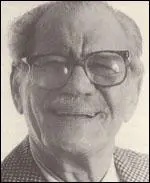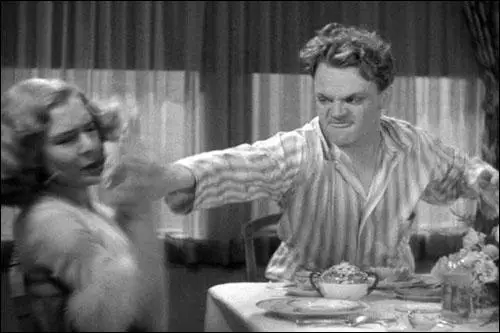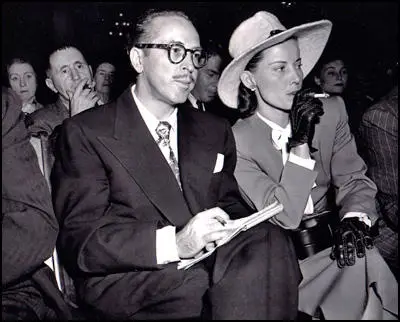John Bright

John Bright was born in Baltimore on 1st January 1908. The family moved to Chicago and as a young man he attended the Hobo College on West Madison Street. His teachers included Emma Goldman, Bill Haywood and Ben Reitman and he came under the influence of the Industrial Workers of the World. (1)
Bright then went on to study at the New School for Social Research in New York City. During this period he became involved in the campaign to free Bartolomeo Vanzetti and Nicola Sacco. "I was intensely concerned about that case, as millions of people in the world were, and I and the entire faculty and student body of the New School went up to Boston for the last-minute picketing plea to the powers that be... Sacco and Vanzetti were murdered... and I was plunged into a terrible despair, a great and disillusionment with my country." (2)
Bright had a variety of jobs while living in Chicago. This included working in a drugstore and as an assistant to Ben Hecht, a journalist working at the Chicago Daily News. He became friends with Kubec Glasmon who introduced him to Al Capone. Bright was present at a banquet at the Commonwealth Hotel when the gangster ordered the murder of two other criminals. The men were immediately beaten to death with baseball bats in front of Bright.
John Bright in Hollywood
Bright wanted to be a writer and in October, 1929, he moved to Hollywood with his friend, Kubec Glasmon. The two men wrote a novel, Beer and Blood, about their experiences in Chicago. (3) It failed to find a publisher but it was eventually it was bought by Darryl Zanuck and he told Bright and Glasmon to turn it into a screenplay. He told them that it had too many different characters and stories and to concentrate on Tom Powers and his friend, Matt Doyle. (4)
Public Enemy, with Powers played by James Cagney, was released in 1931. It was an immediate success with the "story of a wisecracking hood who seemed to delight in a violence indelibly stamped the gangster genre". (5) The most remarkable scene in the film was when Cagney smacked Mae Clarke in the face with a cut grapefruit. Bright argued that Cagney arranged to fake the scene because Clarke was suffering from a cold. However, the director, William Wellman, told Cagney: "Jimmy, look, this is the best scene in the picture. This scene will be talked about for a century... It's got to be real, and if it's real this scene will make you one of the biggest stars in the business... You give it to her, really give it to her."
Cagney was in a dilemma - should he double-cross her or not? He finally decided that he had to do it. "So the look on Mae Clarke's face in the film was real. Not only did Jimmy give it to her, but he added something of his own - he twisted the grapefruit. That grapefruit juice was like a razor - it cut into her, giving her agony; her look was one of surprise and betrayal." (6)

Paul Buhle and Dave Wagner, the authors of Radical Hollywood (2002) argue that Bright was one of the first "left-wingers to have an early remarkable impact" on Hollywood. "Both politically and aesthetically, scriptwriter John Bright was... the first important left-wing innovator in Hollywood. The Public Enemy also had the great box office virtue of relating events that the public knew about from the tabloid press, thus blurring boundaries between news and fiction in ways that only the rare literate, socially critical silent films had done earlier." (7)
Most reviewers were highly critical of the film. Time Magazine: "This is not a Hugoesque fable of gangsters fighting among themselves, but a documentary drama of the bandit standing against society. It carries to its ultimate absurdity the fashion for romanticizing gangsters, for even in defeat the public enemy is endowed with grandeur." (8)
The Public Enemy was a great success and the "newspapers had photographs of the lines going all around the block" to see the film". (9) The film earned nearly seven times its production costs, making it the 9th highest grossing film of 1931. This success resulted in Bright worked on a series of films for Hollywood. This included Smart Money (1931), Blonde Crazy (1931), Gentleman for a Day (1932), Taxi! (1932), The Crowd Roars (1932), Three on a Match (1932), If I Had a Million (1932) and She Done Him Wrong (1932).
Screen Writers Guild
John Bright later recalled that when he first arrived in Hollywood "there was no left-wing movement at all". He was one of the original four secret members in the Hollywood section of the Communist Party of the United States (CPUSA). Another early member was John Howard Lawson, who lectured to young actors, telling them that their performances had to advance the class struggle. (10)
Darryl Zanuck eventually became aware that Bright was bringing in politics into his screenplays. He was unhappy when The Nation described Taxi! as a film with "great social significance". Zanuck asked Bright if that was what he intended, he said yes. Zanuck replied: "I'll be a son of a bitch. I thought it was all cops and robbers." Bright's contract was not renewed and he was out of work for several years. (11)
In 1933 Bright joined forces with other left-wing writers to form the Screen Writers Guild (SWG). This included Dorothy Parker, Donald Ogden Stewart, Alan Campbell, Lillian Hellman, Dashiell Hammett, Lester Cole, Paul Green, Gordon Kahn, John Howard Lawson, Samuel Ornitz, Joseph Mankiewicz, Charles Brackett and Philip Dunne. The film studios responded by refusing to hire Guild members and forming a rival organization called the Screen Playwrights.
Later that year Robert F. Wagner, chairman of the National Recovery Administration, introduced a bill to Congress to help protect trade unionists from their employers. With the support of Frances Perkins, the US Secretary of Labor, Wagner's proposals became the National Labor Relations Act. It established a three man National Labor Relations Board (NLRB) empowered to administer the regulation of labour relations in industries engaged in or affecting interstate commerce.
When the Guild appealed to the NLRB, it certified the Guild as the "exclusive bargaining agency" for screenwriters employed by 13 of 18 Hollywood studios, based on elections in which writers chose the Guild over the Screen Playwrights. By 1936 the Screen Writers Guild claimed that it had over a thousand members. (12)
Victor Jerome
Victor Jerome was the head of the Party's Cultural Commission. For a time, Jerome personally assumed responsibility for the Hollywood branches, "insulating them from the rest of the Party in Los Angeles and keeping them in direct touch with the national leadership". (13) John Howard Lawson ran the Hollywood branch. However, as Victor Navasky, the author of Naming Names (1982) pointed out: "John Howard Lawson, who ran the Hollywood branch, quickly understood that the collective process of movie making precluded the screenwriter, low man on the creative totem pole, from influencing the content of movies." (14)
Jerome was used to defend the actions of Joseph Stalin. He spent a lot of time in Hollywood in the 1930s explaining the Moscow Show Trials, which resulted in the executions of leading figures such as Gregory Zinoviev, Lev Kamenev, Yuri Piatakov, Karl Radek, Grigori Sokolnikov, Nickolai Bukharin, Alexei Rykov, Genrikh Yagoda, Nikolai Krestinsky and Christian Rakovsky. (15)
This caused problems for Jerome as many of its Hollywood members supported the Leon Trotsky wing of the party. At one meeting, John Bright, asked Jerome: "Comrade Jerome, what if a Party decision is made that you cannot go along with?" Jerome replied: "When the Party makes a decision, it becomes your opinion." (16) As a result of these comments Bright left the Communist Party of the United States.
With the rise of power of Adolf Hitler in Nazi Germany, John Bright, anti-fascist beliefs became more mainstream. Bright was one of the founders of the Hollywood Anti-Nazi League (HANL) in 1936. Other members included Dorothy Parker, Alan Campbell, Walter Wanger, Dashiell Hammett, Donald Ogden Stewart, John Howard Lawson, Clifford Odets, Cedric Belfrage, Dudley Nichols, Frederic March, Lewis Milestone, Oscar Hammerstein II, Ernst Lubitsch, Mervyn LeRoy, Gloria Stuart, Sylvia Sidney, F. Scott Fitzgerald, Chico Marx, Benny Goodman, Fred MacMurray and Eddie Cantor. Another member, Philip Dunne, later admitted "I joined the Anti-Nazi League because I wanted to help fight the most vicious subversion of human dignity in modern history". (17)
Bright was very politically active during this period. He supported Upton Sinclair in his attempts to become governor of California. He was executive secretary of the Hollywood Scottsboro Committee, a group set up to gain the freedom of the Scottsboro Nine. Bright also campaigned for the release of the Tom Mooney and Warren Billings. During this period he became great friends with Lincoln Steffens and Ella Winter. (18)
Bright was asked to write the screenplays for several years during the next few years. This included Here Comes Trouble (1936), Girl of the Ozarks (1936), The Accusing Finger (1937), John Meade's Woman (1937), San Quentin (1937) and Back Door to Heaven (1938). Howard Fast, another member of the Communist Party of the United States, later recalled that attempts were made to recruit Bright to write the screenplay of Citizen Tom Paine. (19)
Un-American Activities Committee
During the hearings held by Martin Dies, the first chairman of the Un-American Activities Committee (HUAC), in 1940, it was claimed that John Bright had persuaded James Cagney and Frederic March, to give money to those fighting fascism during the Spanish Civil War. Cagney had given $500 for an ambulance. He commented: "I was raised in poverty and by golly you can't go through life and build walls and say everything is fine for me and to hell with the other fellow." (20)
Despite this testimony John Bright continued to work in Hollywood and was involved in the screenplays of Broadway (1942), Sherlock Holmes and the Voice of Terror (1942), I Walk Alone (1948), Joe Palooka (1948), Close-Up (1948), The Kid from Cleveland (1949) and The Brave Bulls (1951).
After the war the Un-American Activities Committee (HUAC) opened its hearings concerning communist infiltration of the motion picture industry. The first ten men accused of being communists: Alvah Bessie, Herbert Biberman, Albert Maltz, Adrian Scott, Samuel Ornitz, Dalton Trumbo, Lester Cole, Edward Dmytryk, John Howard Lawson and Ring Lardner Jr, refused to answer any questions about their political and union activities. Known as the Hollywood Ten, they claimed that the 1st Amendment of the United States Constitution gave them the right to do this. The HUAC and the courts during appeals disagreed and all were found guilty of contempt of Congress and each was sentenced to between six and twelve months in prison.

John Bright was ordered to appear before the HUAC. Although he had left the Communist Party of the United States a long time ago he was unwilling to testify against former comrades and in 1952 decided to go and live in Mexico and joined a colony of blacklisted screenwriters that included Ring Lardner Jr., Albert Maltz, Hugo Butler, Jean Rouverol and Ian McLellan Hunter. (21)
While in exile he used the name Hal Croves to write black-market scripts. In 1960 Dalton Trumbo became the first blacklisted writer to use his own name when he wrote the screenplay for the film Spartacus. Based on the novel by another left-wing blacklisted writer, Howard Fast, is a film that examines the spirit of revolt. Trumbo refers back to his experiences of the House of Un-American Activities Committee. At the end, when the Romans finally defeat the rebellion, the captured slaves refuse to identify Spartacus.
Bright now returned to Hollywood but found little work. For a time Bright became a story editor to the production company formed by Bill Cosby. He also worked behind the scenes on the 1971 film of Trumbo's anti-war novel, Johnny Got His Gun. The authors of Tender Comrades (1997) pointed out: "A lifelong smoker, drinker, and bon vivant, Bright surprised people merely by staying alive as long as I did. He lived out his years in conditions of shocking poverty in a Hollywood apartment, his mind and tongue acerbic to the end." (22)
John Bright died in 1989.
Primary Sources
(1) Paul Buhle and Dave Wagner, Radical Hollywood (2002)
A native Chicagoan, Bright had been drawn as a youngster toward a fading radical milieu of great significance: hobo-intellectuals, the free-spirited and free-loving bunch around Dr. Ben Reitman and the badly diminished but still evocative Industrial Workers of the World (IWW) headquartered in the Windy City....
Both politically and aesthetically, scriptwriter John Bright was... the first important left-wing innovator in Hollywood. The Public Enemy also had the great box office virtue of relating events that the public knew about from the tabloid press, thus blurring boundaries between news and fiction in ways that only the rare literate, socially critical silent films had done earlier...
Intermittently a communist, Bright was always and more profoundly the product of this environment, the roughneck bohemian who hung out in nightspots and with crowds far below normal Hollywood taste. For those reasons he proved right for one star in particular: James Cagney.
References
(1) Paul Buhle and Dave Wagner, Radical Hollywood (2002) page 14
(2) John Bright, quoted in Tender Comrades (1997) page 130
(3) John McCabe, Cagney (1999) page 420
(4) John Bright, quoted in Tender Comrades (1997) page 132
(5) James Monaco, The International Encyclopedia of Film (1991) page 91
(6) John Bright, quoted in Tender Comrades (1997) page 135
(7) Paul Buhle and Dave Wagner, Radical Hollywood (2002) page 14
(8) Time Magazine (4th May, 1931)
(9) John Bright, quoted in Tender Comrades (1997) page 137
(10) Ted Morgan, Reds: McCarthyism in Twenty-Century America (2003) page 516
(11) John Bright, quoted in Tender Comrades (1997) page 140
(12) Paul Buhle and Dave Wagner, Radical Hollywood (2002) page 45
(13) Paul Buhle and Dave Wagner, Radical Hollywood (2002) page 85
(14) Victor Navasky, Naming Names (1982) page 78
(15) Paul Buhle and Dave Wagner, Radical Hollywood (2002) page 85
(16) John Bright, quoted in Tender Comrades (1997) page 151
(17) Philip Dunne, Take Two: A Life in Movies and Politics (1992) page 110
(18) John Bright, quoted in Tender Comrades (1997) pages 144-148
(19) Howard Fast, Being Red (1990) page 78
(20) James Cagney, testimony to the Un-American Activities Committee (17th August, 1940)
(21) Ring Lardner Jr., I'd Hate Myself in the Morning (2000) page 137
(22) Patrick McGilligan and Paul Buhle, Tender Comrades (1997) page 129
